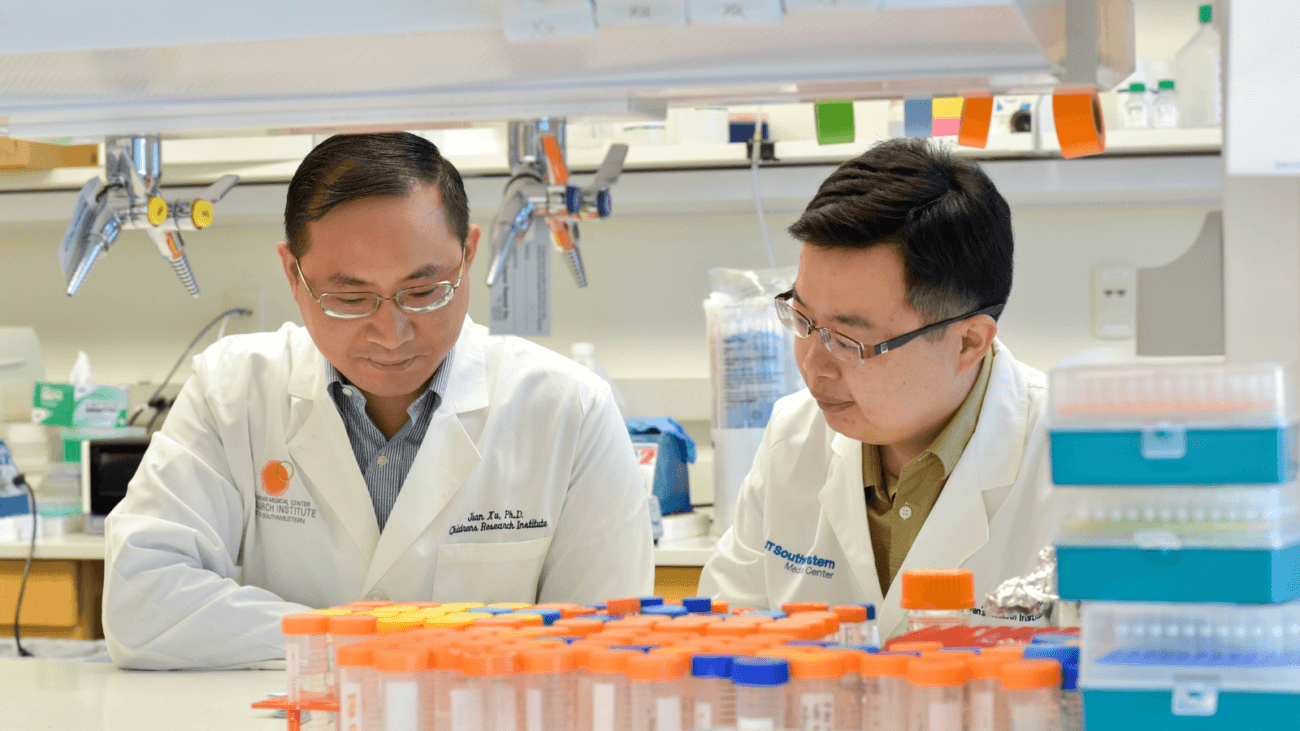
Jian Xu, Ph.D. (left) and Junhua Lyu, Ph.D. (right)
New research has uncovered a previously unknown mechanism that explains why patients with acute myeloid leukemia (AML) often become resistant to common cancer treatments. Scientists at Children’s Medical Center Research Institute at UT Southwestern (CRI) developed new preclinical cell models that allowed them to identify a new class of mutations responsible for resistance to targeted therapies in patients with mutations in their IDH genes. These findings will help researchers investigate the molecular underpinnings, which could lead to new strategies for monitoring AML progression and helping prevent or overcome resistance to targeted cancer therapies.
AML and other cancers often are initiated by mutations that affect IDH genes. These genes encode metabolic enzymes that, when mutated, lead to the generation of a small molecule and oncometabolite known as R-2-hydroxyglutarate (R-2-HG). Accumulation of R-2-HG drives cancer formation. While there are two targeted therapies for AML (ivosidenib and enasidenib) that work by targeting mutant IDH to suppress R-2-HG production, most patients who initially respond eventually relapse. The mutations and underlying mechanisms responsible for resistance to IDH inhibition remain largely unknown since developing the appropriate cell models containing IDH mutations has been difficult.
In the new study, published in Cancer Discovery, scientists in the Xu laboratory overcame this hurdle by using CRISPR base editing to develop a panel of human myeloid leukemia cell lines containing the most common IDH1 and IDH2 oncogenic mutations. These new models allowed researchers, for the first time, to perform a thorough analysis of the mutational landscape using a technique known as saturation variant screening, which identified changes in individual amino acids on IDH genes.
When the team, led by postdoc fellow Junhua Lyu, Ph.D., integrated these results with targeted sequencing of AML patients and structural and functional studies, they uncovered a new class of IDH second-site mutations responsible for acquired resistance. Crucially, these same mutations also were found in AML patients with therapy resistance to IDH inhibition. Normally, IDH inhibitors work by binding to a complex formed by the mutant IDH enzyme and the co-factor NADPH through a process known as uncompetitive inhibition. The presence of IDH second-site mutations prevents the formation of a stable enzyme-inhibitor complex, restores R-2-HG production, and drives therapy resistance in IDH-mutant AML cells and patients.
“These results help explain how disabling the unique biochemical features of IDH inhibitors contributes to the development of clinical resistance,” says Jian Xu, Ph.D., Associate Professor at CRI and senior author of the study. “Our new cell models and the discovery of new IDH second-site mutations with acquired resistance will likely have broad implications for understanding the molecular basis of therapy resistance in human cancers.”
Even though these studies were performed in the context of myeloid leukemia, the approaches established by the Xu lab will apply to other diseases driven by IDH mutations, including gliomas, intrahepatic cholangiocarcinomas, and chondrosarcoma, where IDH inhibitors currently are being evaluated as targeted therapies.
Dr. Xu is an Associate Professor of Pediatrics at UT Southwestern and a Cancer Prevention & Research Institute of Texas (CPRIT) Scholar in Cancer Research. This work was supported by the National Institutes of Health (R01DK111430, R01CA230631, R01CA259581, and R21AI158240), CPRIT (RP180504, RP190417, RP220337, and RP220375), a Leukemia & Lymphoma Society Scholar award, an American Society of Hematology Scholar award, a Welch Foundation grant (I-1942), and donors to the Children’s Medical Center Foundation.


